Financial Management Assignment - Analysis and Recommendations
VerifiedAdded on 2022/12/19
|19
|4217
|1
Homework Assignment
AI Summary
This document provides a comprehensive solution to a financial management assignment, addressing various aspects of corporate finance. It begins with the calculation of taxable income and tax liability, followed by a discussion of the objectives of corporate financial management, including wealth maximization and efficient fund mobilization. The assignment then delves into investment analysis, comparing different investment options, calculating stock and preferred stock values, and determining effective costs. Further sections cover the Economic Ordering Quantity (EOQ) and the Weighted Average Cost of Capital (WACC). The assignment also includes capital budgeting techniques such as Net Present Value (NPV), Payback Period, Accounting Rate of Return (ARR), and Profitability Index, with recommendations for investment decisions. The final parts of the assignment analyze financial ratios, operating, financial, and combined leverage, as well as a detailed analysis of various financial ratios for a given year, providing a complete overview of financial statement analysis and decision-making.
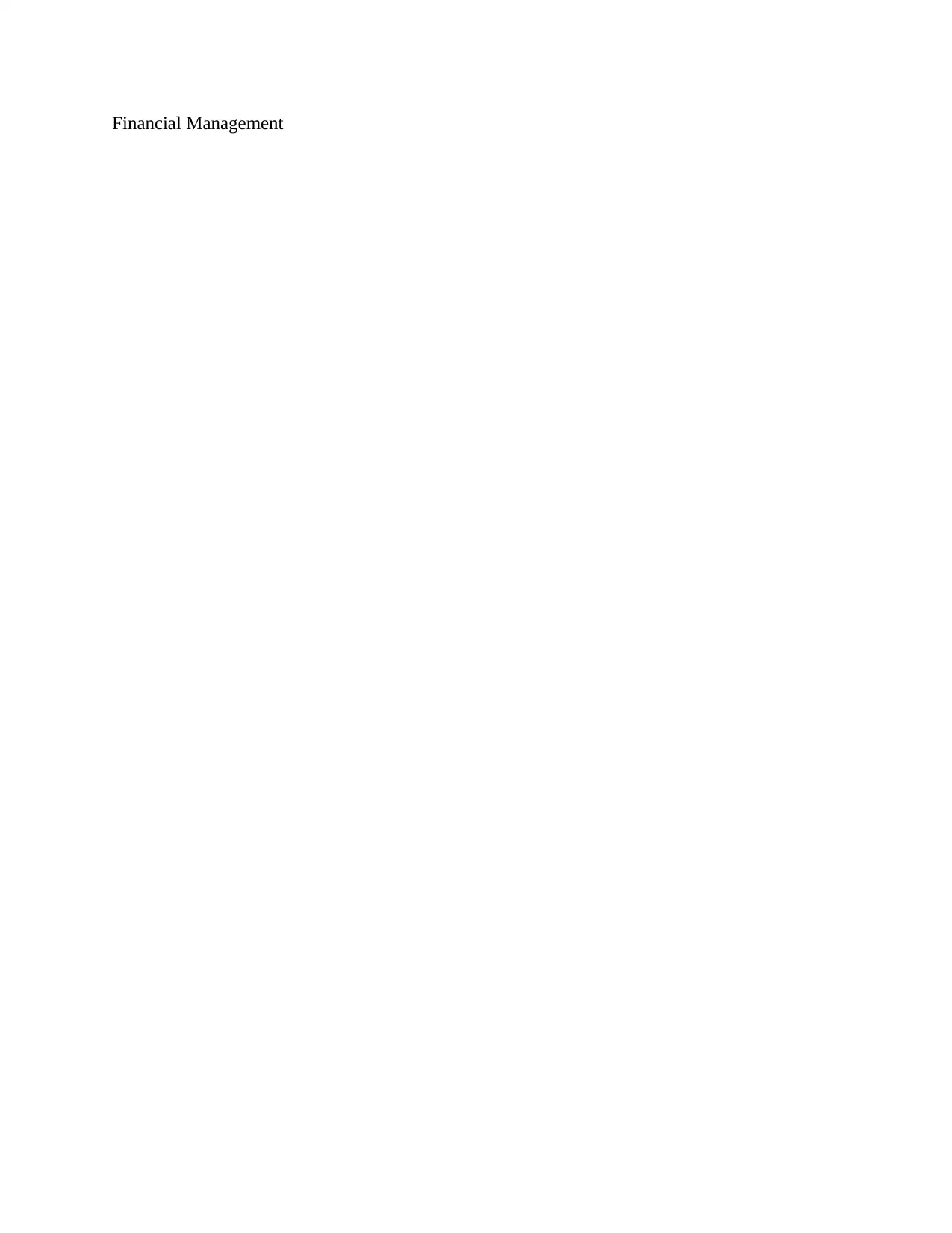
Financial Management
Paraphrase This Document
Need a fresh take? Get an instant paraphrase of this document with our AI Paraphraser
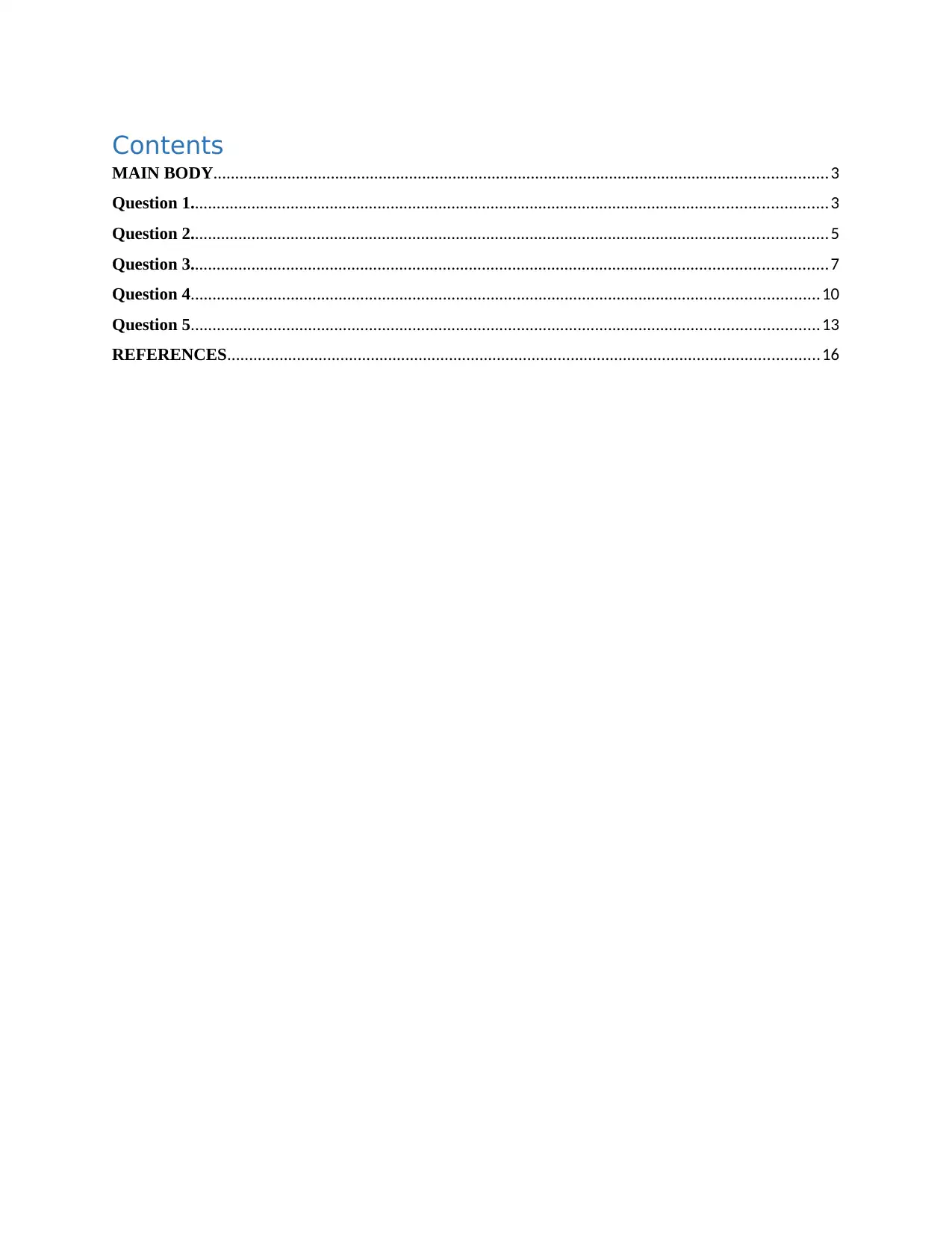
Contents
MAIN BODY.............................................................................................................................................3
Question 1..................................................................................................................................................3
Question 2..................................................................................................................................................5
Question 3..................................................................................................................................................7
Question 4................................................................................................................................................10
Question 5................................................................................................................................................13
REFERENCES........................................................................................................................................16
MAIN BODY.............................................................................................................................................3
Question 1..................................................................................................................................................3
Question 2..................................................................................................................................................5
Question 3..................................................................................................................................................7
Question 4................................................................................................................................................10
Question 5................................................................................................................................................13
REFERENCES........................................................................................................................................16
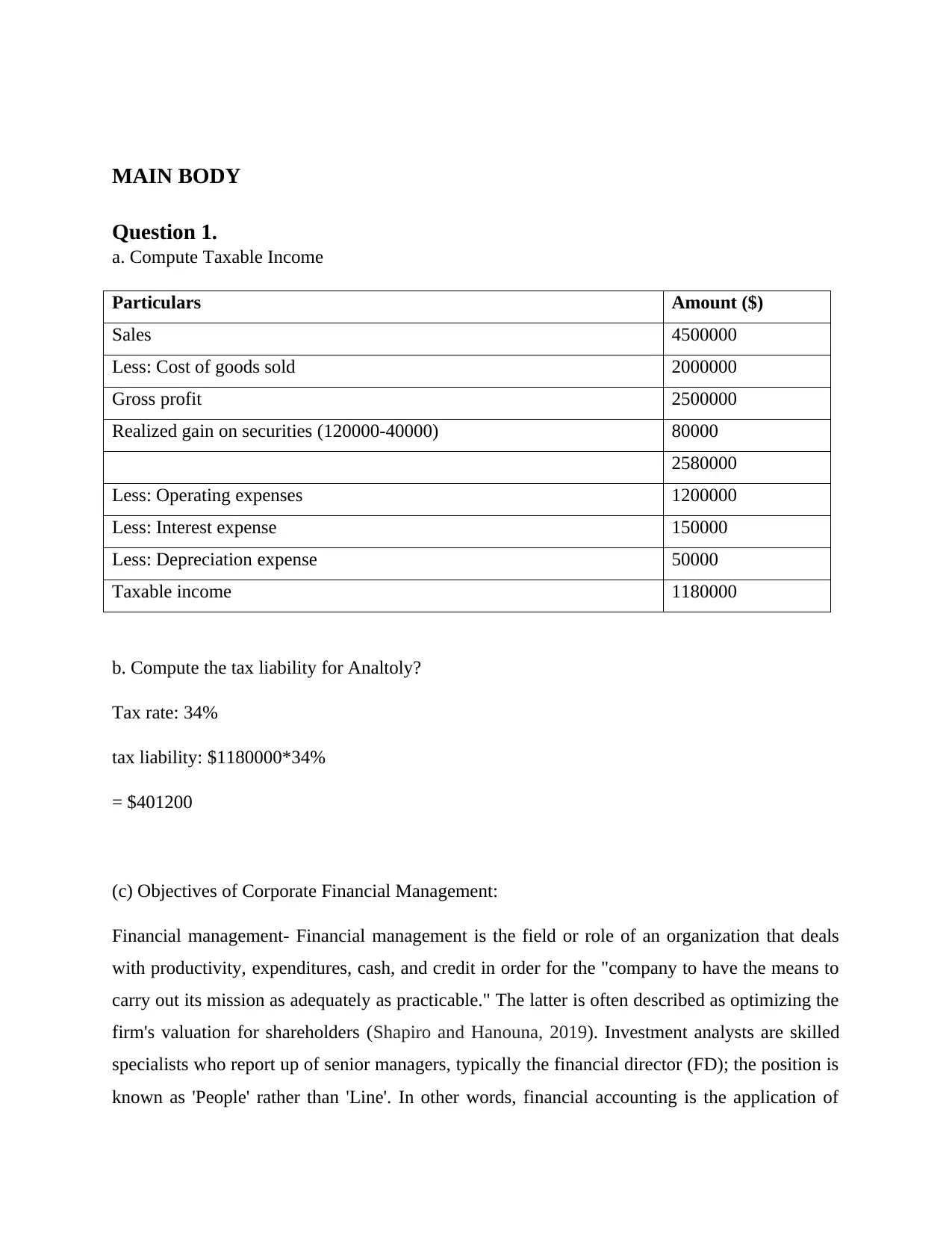
MAIN BODY
Question 1.
a. Compute Taxable Income
Particulars Amount ($)
Sales 4500000
Less: Cost of goods sold 2000000
Gross profit 2500000
Realized gain on securities (120000-40000) 80000
2580000
Less: Operating expenses 1200000
Less: Interest expense 150000
Less: Depreciation expense 50000
Taxable income 1180000
b. Compute the tax liability for Analtoly?
Tax rate: 34%
tax liability: $1180000*34%
= $401200
(c) Objectives of Corporate Financial Management:
Financial management- Financial management is the field or role of an organization that deals
with productivity, expenditures, cash, and credit in order for the "company to have the means to
carry out its mission as adequately as practicable." The latter is often described as optimizing the
firm's valuation for shareholders (Shapiro and Hanouna, 2019). Investment analysts are skilled
specialists who report up of senior managers, typically the financial director (FD); the position is
known as 'People' rather than 'Line'. In other words, financial accounting is the application of
Question 1.
a. Compute Taxable Income
Particulars Amount ($)
Sales 4500000
Less: Cost of goods sold 2000000
Gross profit 2500000
Realized gain on securities (120000-40000) 80000
2580000
Less: Operating expenses 1200000
Less: Interest expense 150000
Less: Depreciation expense 50000
Taxable income 1180000
b. Compute the tax liability for Analtoly?
Tax rate: 34%
tax liability: $1180000*34%
= $401200
(c) Objectives of Corporate Financial Management:
Financial management- Financial management is the field or role of an organization that deals
with productivity, expenditures, cash, and credit in order for the "company to have the means to
carry out its mission as adequately as practicable." The latter is often described as optimizing the
firm's valuation for shareholders (Shapiro and Hanouna, 2019). Investment analysts are skilled
specialists who report up of senior managers, typically the financial director (FD); the position is
known as 'People' rather than 'Line'. In other words, financial accounting is the application of
⊘ This is a preview!⊘
Do you want full access?
Subscribe today to unlock all pages.

Trusted by 1+ million students worldwide

general management concepts to an organization's financial properties. Quality gasoline and
routine service are provided by proper financial management in order for an organization's
operations to run smoothly. If an organization's budgets aren't handled adequately, it can face
roadblocks that might stifle its growth and progress (Finkler,Smith and Calabrese, 2018). Below
some key objective of financial management are explained in such manner:
Wealth maximization: Financial accounting also has as a primary goal the maximization
of wealth (shareholder value). The term "wealth maximization" refers to maximizing
profits for owners (Yuniningsih, Pertiwi and Purwanto, 2019). As a result, the financial
officer strives to pay the highest possible payout to the owners. He also seeks to increase
the stock's market valuation. The market price of the new equity is directly proportional
to its output. The higher the results, the higher the equity price valuation, and vice versa.
As a consequence, the finance officer would aim to increase value for shareholders.
Proper estimation of total financial requirements: Financial management's primary goal is
to accurately estimate overall financial needs. The company's overall budgetary needs
must be estimated by the finance officer. He has to work out how much money he'll need
to start and run the firm. He would assess the higher capital and operating capital needs.
He must be right in his judgment. Otherwise, there would be a cash shortage or surplus.
Trying to estimate the financial criteria is a daunting challenge. Many considerations
must be considered by the financial manager, including the type of technology used by
the corporation, the number of workers hired, the size of operations, regulatory
regulations, and so on.
Proper mobilization- The mobilization (collection) of funds is a key goal of financial
management. The finance organization must know on the sources of funds after
calculating the financial criteria (Ameliawati and Setiyani, 2018). This may get money
from a number of ways, including bonds, preferred stock, and bank loans. A proper
balance between held and loan financing is needed. The business wants to borrow money
at a low rate.
Maintaining proper cash flow- Financial management's short-term goal is to maintain
sufficient cash flow. The business wants a good cash balance to meet day-to-day costs
like buying raw materials, paying wages and bonuses, paying rent, paying energy bills,
and so on (Yap, Komalasari,andHadiansah, 2018). If a capital structure is high, it can
routine service are provided by proper financial management in order for an organization's
operations to run smoothly. If an organization's budgets aren't handled adequately, it can face
roadblocks that might stifle its growth and progress (Finkler,Smith and Calabrese, 2018). Below
some key objective of financial management are explained in such manner:
Wealth maximization: Financial accounting also has as a primary goal the maximization
of wealth (shareholder value). The term "wealth maximization" refers to maximizing
profits for owners (Yuniningsih, Pertiwi and Purwanto, 2019). As a result, the financial
officer strives to pay the highest possible payout to the owners. He also seeks to increase
the stock's market valuation. The market price of the new equity is directly proportional
to its output. The higher the results, the higher the equity price valuation, and vice versa.
As a consequence, the finance officer would aim to increase value for shareholders.
Proper estimation of total financial requirements: Financial management's primary goal is
to accurately estimate overall financial needs. The company's overall budgetary needs
must be estimated by the finance officer. He has to work out how much money he'll need
to start and run the firm. He would assess the higher capital and operating capital needs.
He must be right in his judgment. Otherwise, there would be a cash shortage or surplus.
Trying to estimate the financial criteria is a daunting challenge. Many considerations
must be considered by the financial manager, including the type of technology used by
the corporation, the number of workers hired, the size of operations, regulatory
regulations, and so on.
Proper mobilization- The mobilization (collection) of funds is a key goal of financial
management. The finance organization must know on the sources of funds after
calculating the financial criteria (Ameliawati and Setiyani, 2018). This may get money
from a number of ways, including bonds, preferred stock, and bank loans. A proper
balance between held and loan financing is needed. The business wants to borrow money
at a low rate.
Maintaining proper cash flow- Financial management's short-term goal is to maintain
sufficient cash flow. The business wants a good cash balance to meet day-to-day costs
like buying raw materials, paying wages and bonuses, paying rent, paying energy bills,
and so on (Yap, Komalasari,andHadiansah, 2018). If a capital structure is high, it can
Paraphrase This Document
Need a fresh take? Get an instant paraphrase of this document with our AI Paraphraser
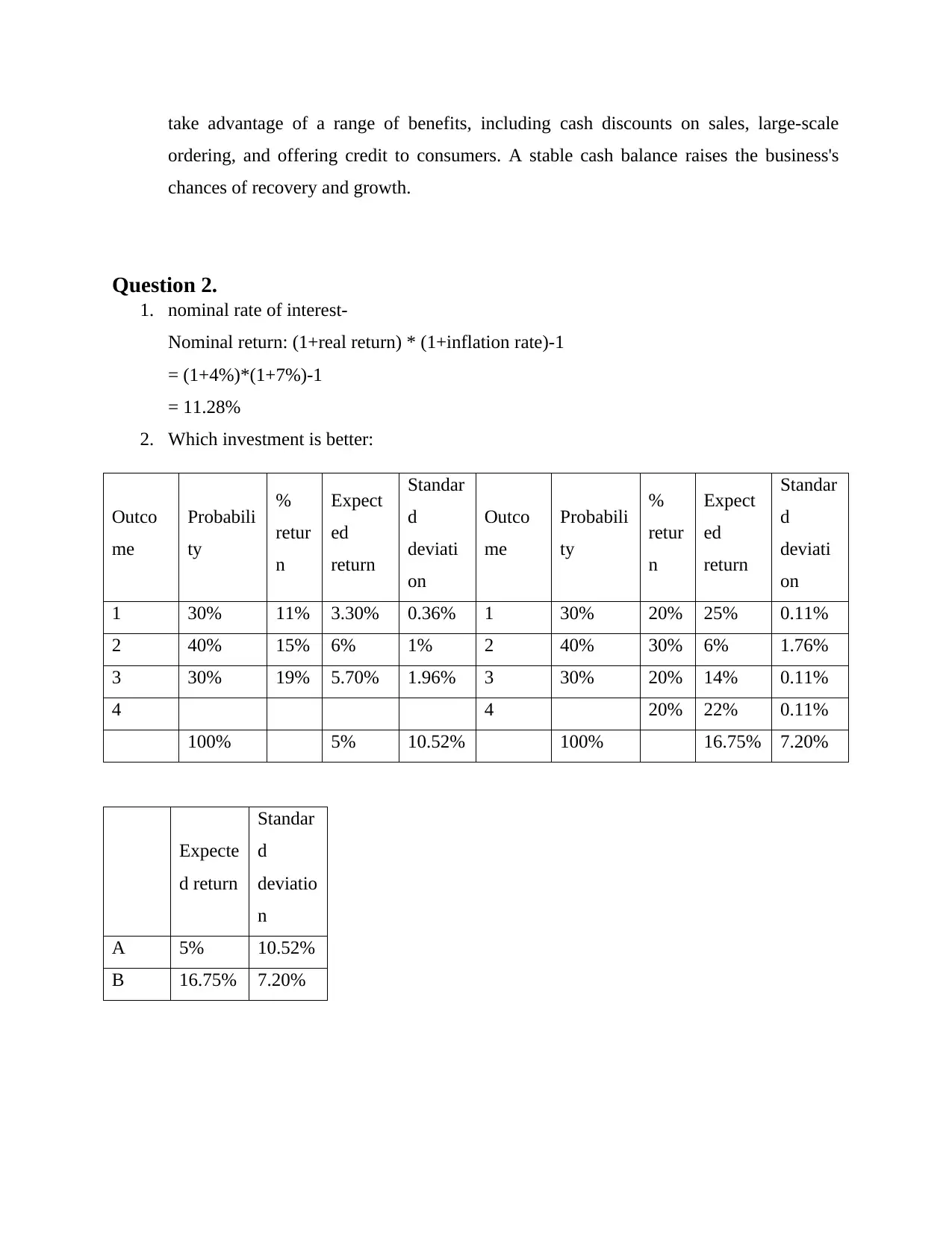
take advantage of a range of benefits, including cash discounts on sales, large-scale
ordering, and offering credit to consumers. A stable cash balance raises the business's
chances of recovery and growth.
Question 2.
1. nominal rate of interest-
Nominal return: (1+real return) * (1+inflation rate)-1
= (1+4%)*(1+7%)-1
= 11.28%
2. Which investment is better:
Outco
me
Probabili
ty
%
retur
n
Expect
ed
return
Standar
d
deviati
on
Outco
me
Probabili
ty
%
retur
n
Expect
ed
return
Standar
d
deviati
on
1 30% 11% 3.30% 0.36% 1 30% 20% 25% 0.11%
2 40% 15% 6% 1% 2 40% 30% 6% 1.76%
3 30% 19% 5.70% 1.96% 3 30% 20% 14% 0.11%
4 4 20% 22% 0.11%
100% 5% 10.52% 100% 16.75% 7.20%
Expecte
d return
Standar
d
deviatio
n
A 5% 10.52%
B 16.75% 7.20%
ordering, and offering credit to consumers. A stable cash balance raises the business's
chances of recovery and growth.
Question 2.
1. nominal rate of interest-
Nominal return: (1+real return) * (1+inflation rate)-1
= (1+4%)*(1+7%)-1
= 11.28%
2. Which investment is better:
Outco
me
Probabili
ty
%
retur
n
Expect
ed
return
Standar
d
deviati
on
Outco
me
Probabili
ty
%
retur
n
Expect
ed
return
Standar
d
deviati
on
1 30% 11% 3.30% 0.36% 1 30% 20% 25% 0.11%
2 40% 15% 6% 1% 2 40% 30% 6% 1.76%
3 30% 19% 5.70% 1.96% 3 30% 20% 14% 0.11%
4 4 20% 22% 0.11%
100% 5% 10.52% 100% 16.75% 7.20%
Expecte
d return
Standar
d
deviatio
n
A 5% 10.52%
B 16.75% 7.20%

Analysis: In accordance of above measured value of estimated return, this can be stated that
project B seems suitable as compared to B. This is so because under it returns is higher as well as
risk is also lower.
3. what is the value of the common stock?
Value of common stock: Dividend in year one/ (Required Return-Growth rate)
= 3.5* (1+5%)/ (20%-5%)
= 24.5%
4. What is the value of a preferred stock?
Value of preferred stock: Preferred dividend / appropriate discount rate
= 100*14%/12%
= 14/12%
= $116.67
5. Calculate the effective cost
(a) 2/10, net 30= [2%/ (100%-2%)] *[365/ (30-10 days)]
= [(2%/98%)] * [(365/20)]
= 37.24%
(b) 3/15, net 30= [3%/ (100%-3%)] *[365/ (30-15 days)]
= [(3%/97%)] *[(365/15)]
= 75.26%
6. Determine the effective annualized cost
(a) 1/10, net 20= [1%/ (100%-1%)] * [365 / (20-10 days)]
= (1%/99%)*(365/10)
= 36.87%
project B seems suitable as compared to B. This is so because under it returns is higher as well as
risk is also lower.
3. what is the value of the common stock?
Value of common stock: Dividend in year one/ (Required Return-Growth rate)
= 3.5* (1+5%)/ (20%-5%)
= 24.5%
4. What is the value of a preferred stock?
Value of preferred stock: Preferred dividend / appropriate discount rate
= 100*14%/12%
= 14/12%
= $116.67
5. Calculate the effective cost
(a) 2/10, net 30= [2%/ (100%-2%)] *[365/ (30-10 days)]
= [(2%/98%)] * [(365/20)]
= 37.24%
(b) 3/15, net 30= [3%/ (100%-3%)] *[365/ (30-15 days)]
= [(3%/97%)] *[(365/15)]
= 75.26%
6. Determine the effective annualized cost
(a) 1/10, net 20= [1%/ (100%-1%)] * [365 / (20-10 days)]
= (1%/99%)*(365/10)
= 36.87%
⊘ This is a preview!⊘
Do you want full access?
Subscribe today to unlock all pages.

Trusted by 1+ million students worldwide
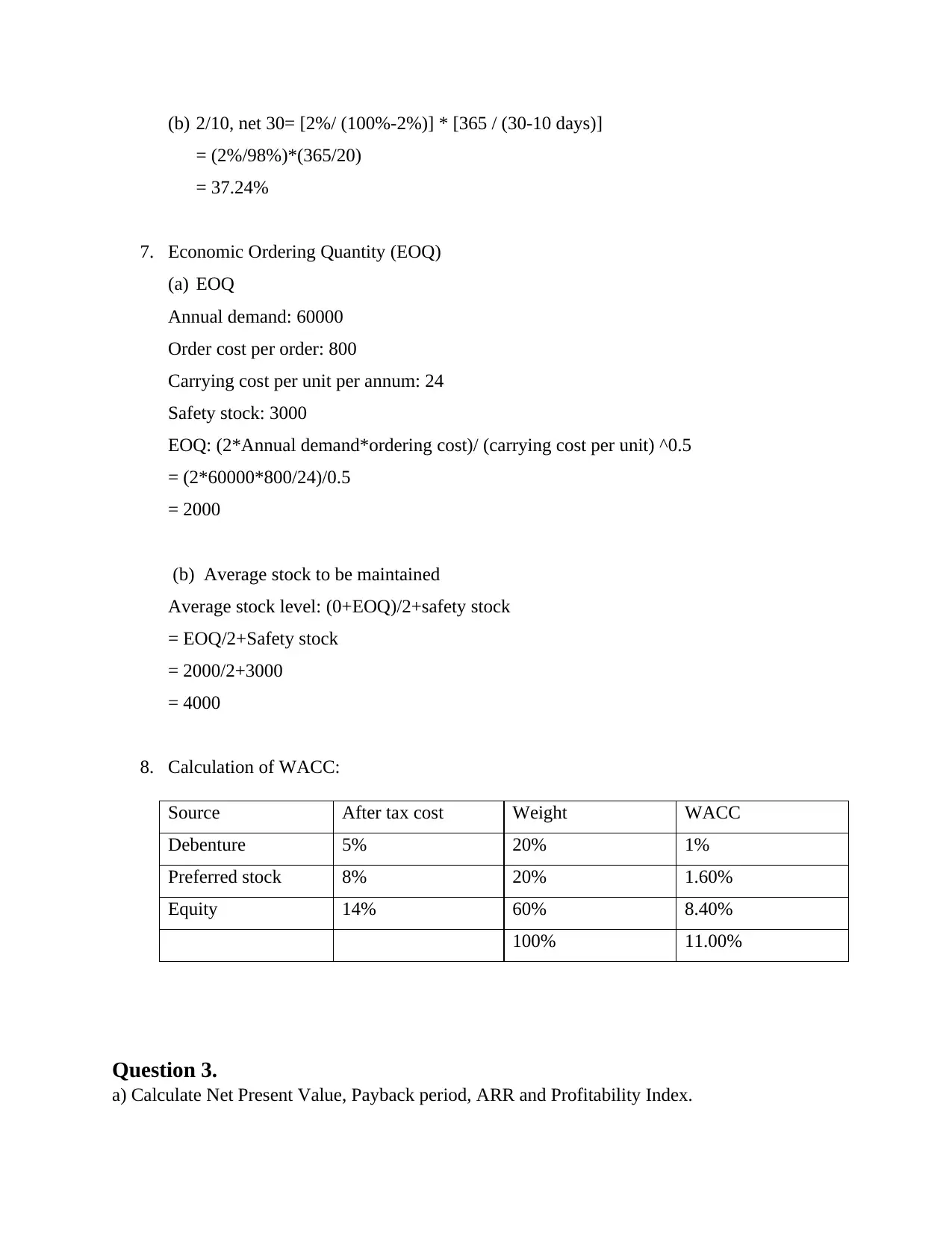
(b) 2/10, net 30= [2%/ (100%-2%)] * [365 / (30-10 days)]
= (2%/98%)*(365/20)
= 37.24%
7. Economic Ordering Quantity (EOQ)
(a) EOQ
Annual demand: 60000
Order cost per order: 800
Carrying cost per unit per annum: 24
Safety stock: 3000
EOQ: (2*Annual demand*ordering cost)/ (carrying cost per unit) ^0.5
= (2*60000*800/24)/0.5
= 2000
(b) Average stock to be maintained
Average stock level: (0+EOQ)/2+safety stock
= EOQ/2+Safety stock
= 2000/2+3000
= 4000
8. Calculation of WACC:
Source After tax cost Weight WACC
Debenture 5% 20% 1%
Preferred stock 8% 20% 1.60%
Equity 14% 60% 8.40%
100% 11.00%
Question 3.
a) Calculate Net Present Value, Payback period, ARR and Profitability Index.
= (2%/98%)*(365/20)
= 37.24%
7. Economic Ordering Quantity (EOQ)
(a) EOQ
Annual demand: 60000
Order cost per order: 800
Carrying cost per unit per annum: 24
Safety stock: 3000
EOQ: (2*Annual demand*ordering cost)/ (carrying cost per unit) ^0.5
= (2*60000*800/24)/0.5
= 2000
(b) Average stock to be maintained
Average stock level: (0+EOQ)/2+safety stock
= EOQ/2+Safety stock
= 2000/2+3000
= 4000
8. Calculation of WACC:
Source After tax cost Weight WACC
Debenture 5% 20% 1%
Preferred stock 8% 20% 1.60%
Equity 14% 60% 8.40%
100% 11.00%
Question 3.
a) Calculate Net Present Value, Payback period, ARR and Profitability Index.
Paraphrase This Document
Need a fresh take? Get an instant paraphrase of this document with our AI Paraphraser
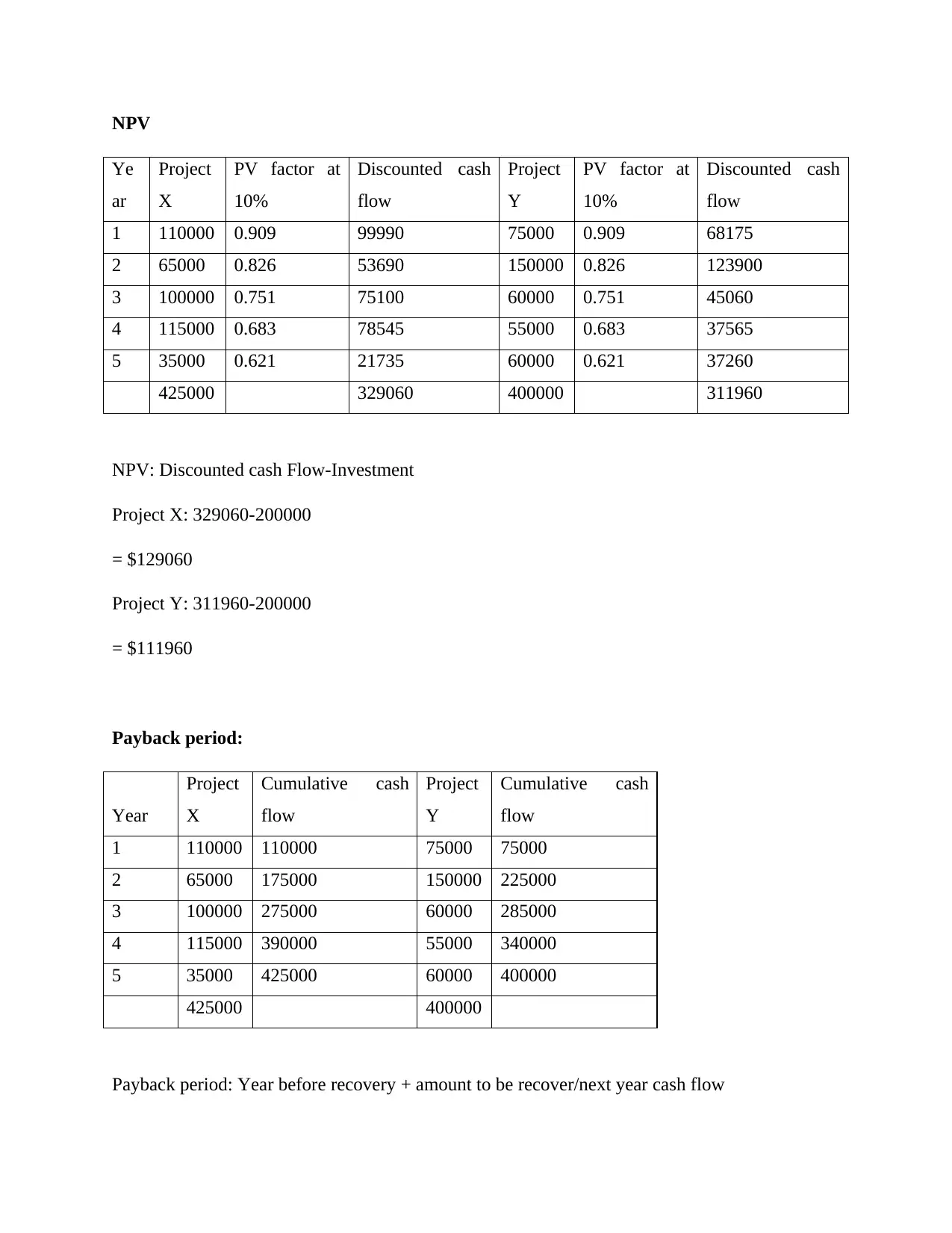
NPV
Ye
ar
Project
X
PV factor at
10%
Discounted cash
flow
Project
Y
PV factor at
10%
Discounted cash
flow
1 110000 0.909 99990 75000 0.909 68175
2 65000 0.826 53690 150000 0.826 123900
3 100000 0.751 75100 60000 0.751 45060
4 115000 0.683 78545 55000 0.683 37565
5 35000 0.621 21735 60000 0.621 37260
425000 329060 400000 311960
NPV: Discounted cash Flow-Investment
Project X: 329060-200000
= $129060
Project Y: 311960-200000
= $111960
Payback period:
Year
Project
X
Cumulative cash
flow
Project
Y
Cumulative cash
flow
1 110000 110000 75000 75000
2 65000 175000 150000 225000
3 100000 275000 60000 285000
4 115000 390000 55000 340000
5 35000 425000 60000 400000
425000 400000
Payback period: Year before recovery + amount to be recover/next year cash flow
Ye
ar
Project
X
PV factor at
10%
Discounted cash
flow
Project
Y
PV factor at
10%
Discounted cash
flow
1 110000 0.909 99990 75000 0.909 68175
2 65000 0.826 53690 150000 0.826 123900
3 100000 0.751 75100 60000 0.751 45060
4 115000 0.683 78545 55000 0.683 37565
5 35000 0.621 21735 60000 0.621 37260
425000 329060 400000 311960
NPV: Discounted cash Flow-Investment
Project X: 329060-200000
= $129060
Project Y: 311960-200000
= $111960
Payback period:
Year
Project
X
Cumulative cash
flow
Project
Y
Cumulative cash
flow
1 110000 110000 75000 75000
2 65000 175000 150000 225000
3 100000 275000 60000 285000
4 115000 390000 55000 340000
5 35000 425000 60000 400000
425000 400000
Payback period: Year before recovery + amount to be recover/next year cash flow

Project X: 2+ (200000-175000)/100000
= 2+25000/100000
= 2.25 Years or 2 years and 3 months
Project Y: 1+ (200000-75000)/150000
= 1+ 125000/150000
= 1.83 Years or 1 year and 10 months
ARR
Formula: Average net income/investment*100
Project X:
Average net income= 425000/5
= 85000
ARR: 85000/200000*100
= 42.5%
Project Y:
Average net income= 400000/5
= 80000
ARR: 80000/200000*100
= 40%
Profitability index:
= 2+25000/100000
= 2.25 Years or 2 years and 3 months
Project Y: 1+ (200000-75000)/150000
= 1+ 125000/150000
= 1.83 Years or 1 year and 10 months
ARR
Formula: Average net income/investment*100
Project X:
Average net income= 425000/5
= 85000
ARR: 85000/200000*100
= 42.5%
Project Y:
Average net income= 400000/5
= 80000
ARR: 80000/200000*100
= 40%
Profitability index:
⊘ This is a preview!⊘
Do you want full access?
Subscribe today to unlock all pages.

Trusted by 1+ million students worldwide
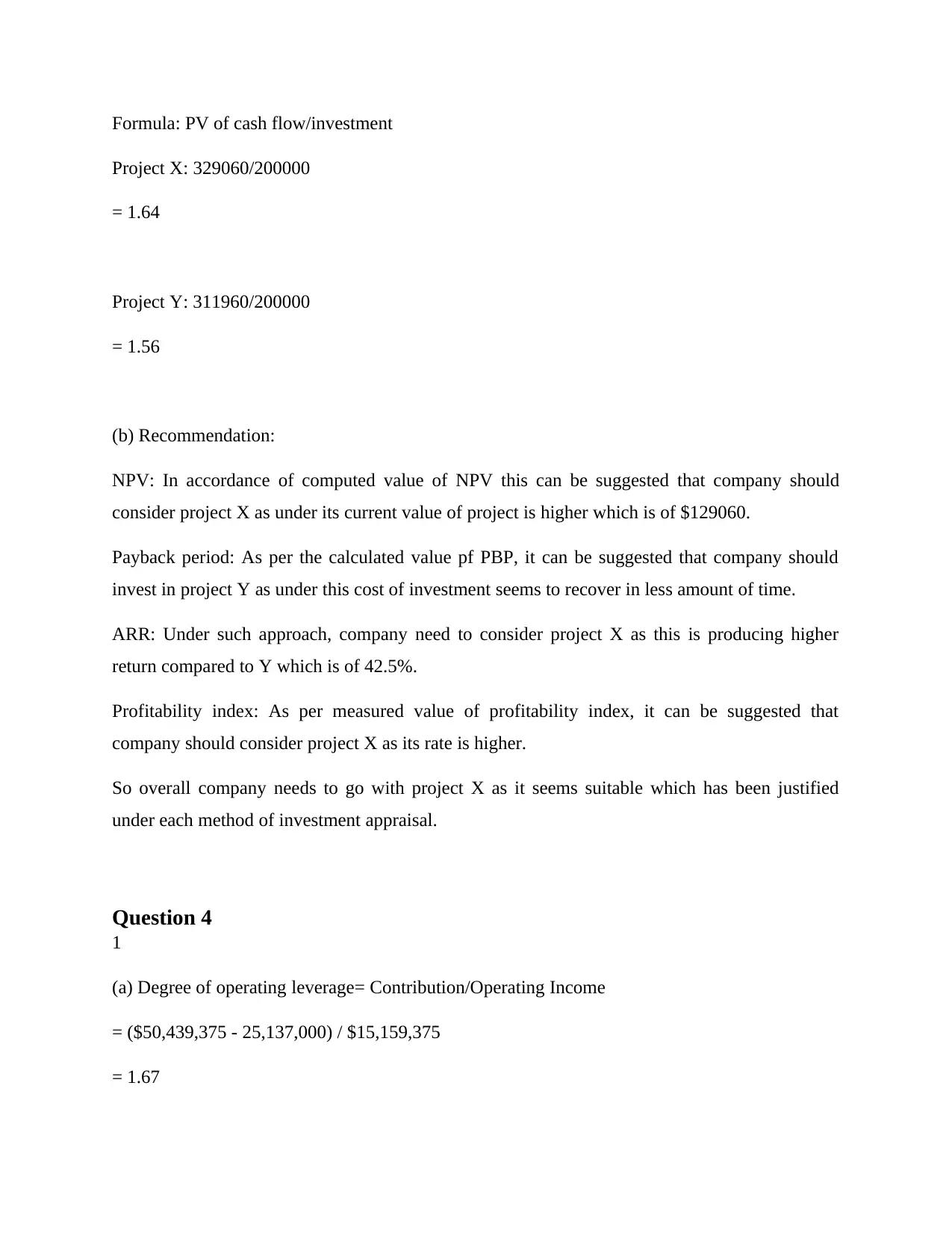
Formula: PV of cash flow/investment
Project X: 329060/200000
= 1.64
Project Y: 311960/200000
= 1.56
(b) Recommendation:
NPV: In accordance of computed value of NPV this can be suggested that company should
consider project X as under its current value of project is higher which is of $129060.
Payback period: As per the calculated value pf PBP, it can be suggested that company should
invest in project Y as under this cost of investment seems to recover in less amount of time.
ARR: Under such approach, company need to consider project X as this is producing higher
return compared to Y which is of 42.5%.
Profitability index: As per measured value of profitability index, it can be suggested that
company should consider project X as its rate is higher.
So overall company needs to go with project X as it seems suitable which has been justified
under each method of investment appraisal.
Question 4
1
(a) Degree of operating leverage= Contribution/Operating Income
= ($50,439,375 - 25,137,000) / $15,159,375
= 1.67
Project X: 329060/200000
= 1.64
Project Y: 311960/200000
= 1.56
(b) Recommendation:
NPV: In accordance of computed value of NPV this can be suggested that company should
consider project X as under its current value of project is higher which is of $129060.
Payback period: As per the calculated value pf PBP, it can be suggested that company should
invest in project Y as under this cost of investment seems to recover in less amount of time.
ARR: Under such approach, company need to consider project X as this is producing higher
return compared to Y which is of 42.5%.
Profitability index: As per measured value of profitability index, it can be suggested that
company should consider project X as its rate is higher.
So overall company needs to go with project X as it seems suitable which has been justified
under each method of investment appraisal.
Question 4
1
(a) Degree of operating leverage= Contribution/Operating Income
= ($50,439,375 - 25,137,000) / $15,159,375
= 1.67
Paraphrase This Document
Need a fresh take? Get an instant paraphrase of this document with our AI Paraphraser
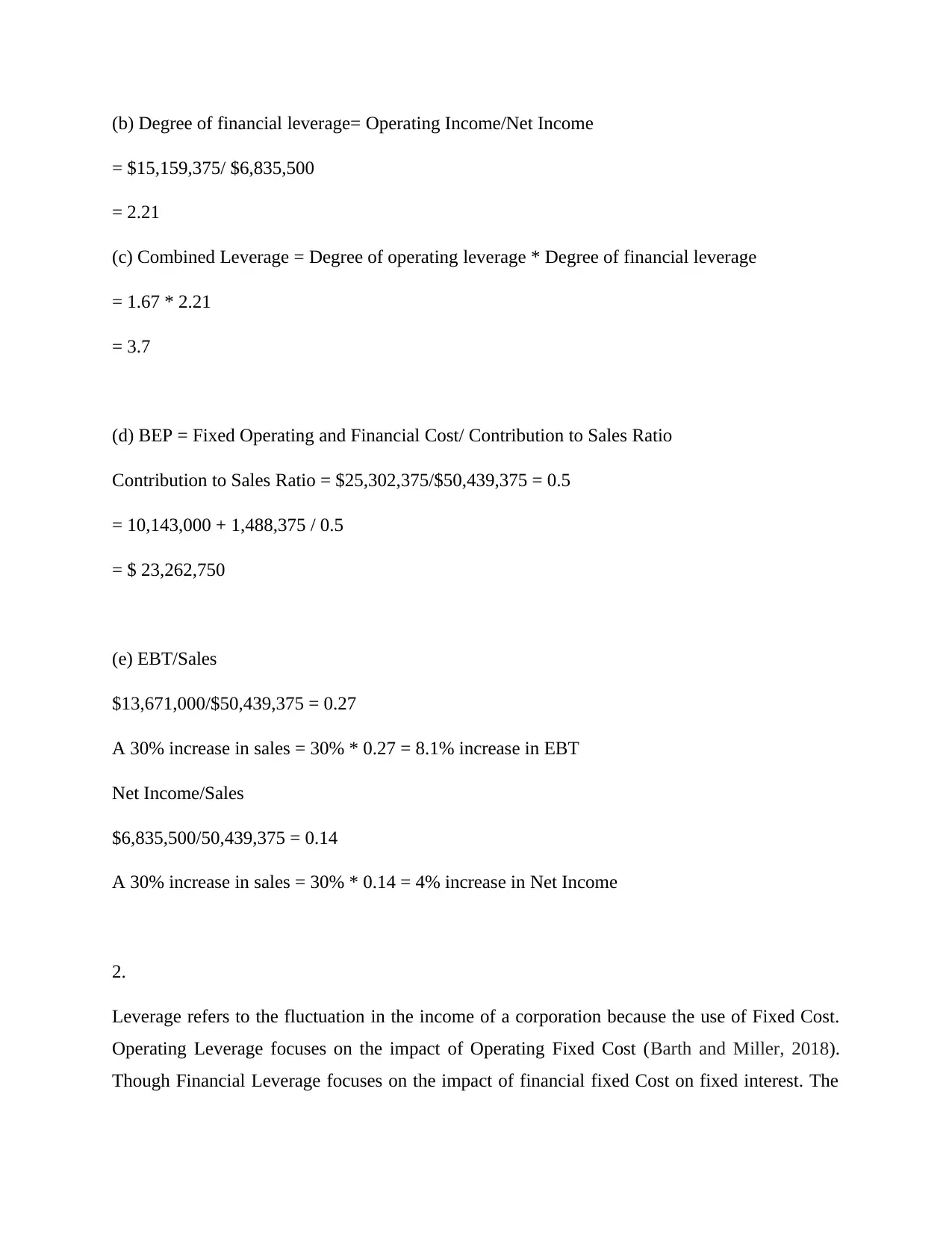
(b) Degree of financial leverage= Operating Income/Net Income
= $15,159,375/ $6,835,500
= 2.21
(c) Combined Leverage = Degree of operating leverage * Degree of financial leverage
= 1.67 * 2.21
= 3.7
(d) BEP = Fixed Operating and Financial Cost/ Contribution to Sales Ratio
Contribution to Sales Ratio = $25,302,375/$50,439,375 = 0.5
= 10,143,000 + 1,488,375 / 0.5
= $ 23,262,750
(e) EBT/Sales
$13,671,000/$50,439,375 = 0.27
A 30% increase in sales = 30% * 0.27 = 8.1% increase in EBT
Net Income/Sales
$6,835,500/50,439,375 = 0.14
A 30% increase in sales = 30% * 0.14 = 4% increase in Net Income
2.
Leverage refers to the fluctuation in the income of a corporation because the use of Fixed Cost.
Operating Leverage focuses on the impact of Operating Fixed Cost (Barth and Miller, 2018).
Though Financial Leverage focuses on the impact of financial fixed Cost on fixed interest. The
= $15,159,375/ $6,835,500
= 2.21
(c) Combined Leverage = Degree of operating leverage * Degree of financial leverage
= 1.67 * 2.21
= 3.7
(d) BEP = Fixed Operating and Financial Cost/ Contribution to Sales Ratio
Contribution to Sales Ratio = $25,302,375/$50,439,375 = 0.5
= 10,143,000 + 1,488,375 / 0.5
= $ 23,262,750
(e) EBT/Sales
$13,671,000/$50,439,375 = 0.27
A 30% increase in sales = 30% * 0.27 = 8.1% increase in EBT
Net Income/Sales
$6,835,500/50,439,375 = 0.14
A 30% increase in sales = 30% * 0.14 = 4% increase in Net Income
2.
Leverage refers to the fluctuation in the income of a corporation because the use of Fixed Cost.
Operating Leverage focuses on the impact of Operating Fixed Cost (Barth and Miller, 2018).
Though Financial Leverage focuses on the impact of financial fixed Cost on fixed interest. The
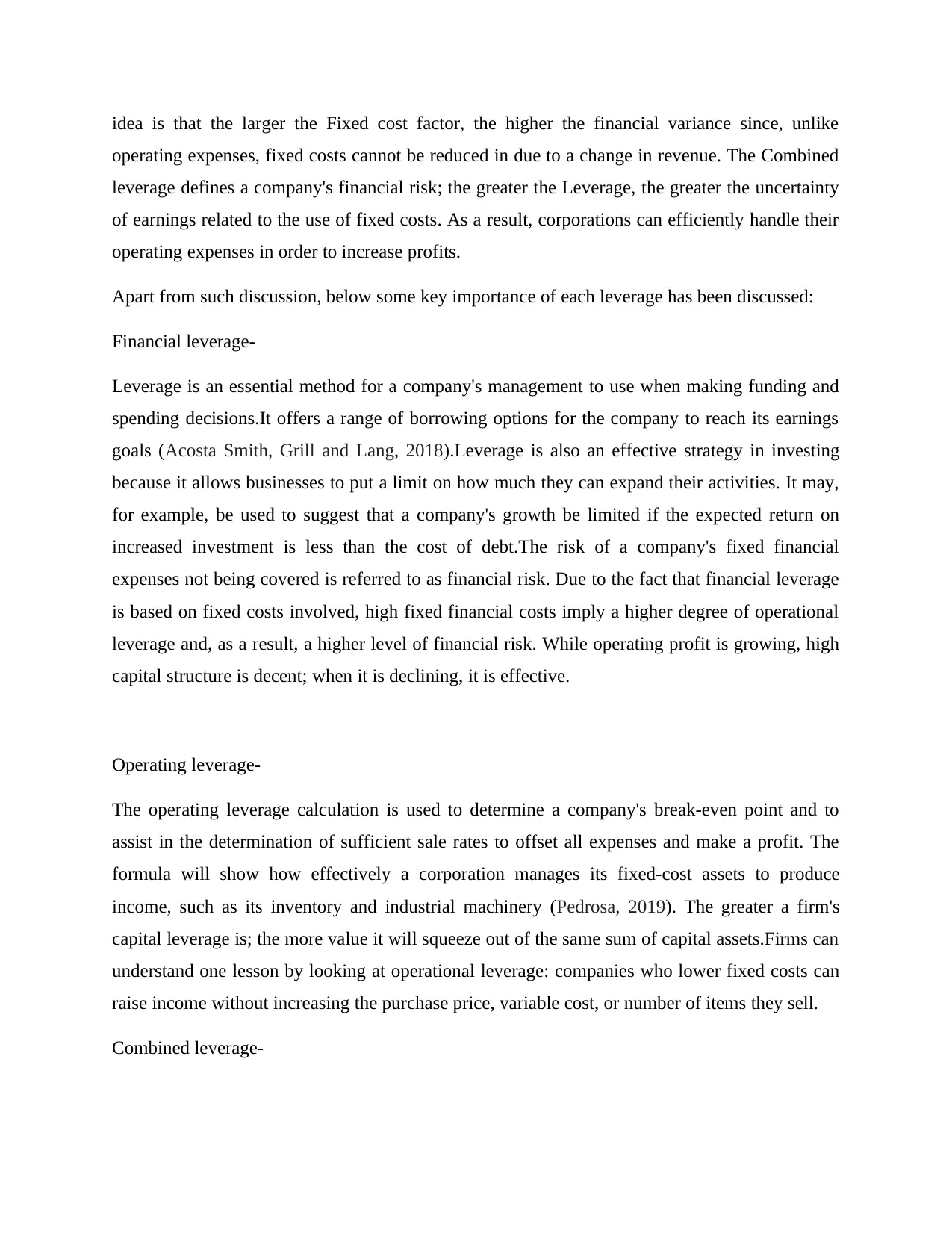
idea is that the larger the Fixed cost factor, the higher the financial variance since, unlike
operating expenses, fixed costs cannot be reduced in due to a change in revenue. The Combined
leverage defines a company's financial risk; the greater the Leverage, the greater the uncertainty
of earnings related to the use of fixed costs. As a result, corporations can efficiently handle their
operating expenses in order to increase profits.
Apart from such discussion, below some key importance of each leverage has been discussed:
Financial leverage-
Leverage is an essential method for a company's management to use when making funding and
spending decisions.It offers a range of borrowing options for the company to reach its earnings
goals (Acosta Smith, Grill and Lang, 2018).Leverage is also an effective strategy in investing
because it allows businesses to put a limit on how much they can expand their activities. It may,
for example, be used to suggest that a company's growth be limited if the expected return on
increased investment is less than the cost of debt.The risk of a company's fixed financial
expenses not being covered is referred to as financial risk. Due to the fact that financial leverage
is based on fixed costs involved, high fixed financial costs imply a higher degree of operational
leverage and, as a result, a higher level of financial risk. While operating profit is growing, high
capital structure is decent; when it is declining, it is effective.
Operating leverage-
The operating leverage calculation is used to determine a company's break-even point and to
assist in the determination of sufficient sale rates to offset all expenses and make a profit. The
formula will show how effectively a corporation manages its fixed-cost assets to produce
income, such as its inventory and industrial machinery (Pedrosa, 2019). The greater a firm's
capital leverage is; the more value it will squeeze out of the same sum of capital assets.Firms can
understand one lesson by looking at operational leverage: companies who lower fixed costs can
raise income without increasing the purchase price, variable cost, or number of items they sell.
Combined leverage-
operating expenses, fixed costs cannot be reduced in due to a change in revenue. The Combined
leverage defines a company's financial risk; the greater the Leverage, the greater the uncertainty
of earnings related to the use of fixed costs. As a result, corporations can efficiently handle their
operating expenses in order to increase profits.
Apart from such discussion, below some key importance of each leverage has been discussed:
Financial leverage-
Leverage is an essential method for a company's management to use when making funding and
spending decisions.It offers a range of borrowing options for the company to reach its earnings
goals (Acosta Smith, Grill and Lang, 2018).Leverage is also an effective strategy in investing
because it allows businesses to put a limit on how much they can expand their activities. It may,
for example, be used to suggest that a company's growth be limited if the expected return on
increased investment is less than the cost of debt.The risk of a company's fixed financial
expenses not being covered is referred to as financial risk. Due to the fact that financial leverage
is based on fixed costs involved, high fixed financial costs imply a higher degree of operational
leverage and, as a result, a higher level of financial risk. While operating profit is growing, high
capital structure is decent; when it is declining, it is effective.
Operating leverage-
The operating leverage calculation is used to determine a company's break-even point and to
assist in the determination of sufficient sale rates to offset all expenses and make a profit. The
formula will show how effectively a corporation manages its fixed-cost assets to produce
income, such as its inventory and industrial machinery (Pedrosa, 2019). The greater a firm's
capital leverage is; the more value it will squeeze out of the same sum of capital assets.Firms can
understand one lesson by looking at operational leverage: companies who lower fixed costs can
raise income without increasing the purchase price, variable cost, or number of items they sell.
Combined leverage-
⊘ This is a preview!⊘
Do you want full access?
Subscribe today to unlock all pages.

Trusted by 1+ million students worldwide
1 out of 19
Related Documents
Your All-in-One AI-Powered Toolkit for Academic Success.
+13062052269
info@desklib.com
Available 24*7 on WhatsApp / Email
![[object Object]](/_next/static/media/star-bottom.7253800d.svg)
Unlock your academic potential
Copyright © 2020–2025 A2Z Services. All Rights Reserved. Developed and managed by ZUCOL.



